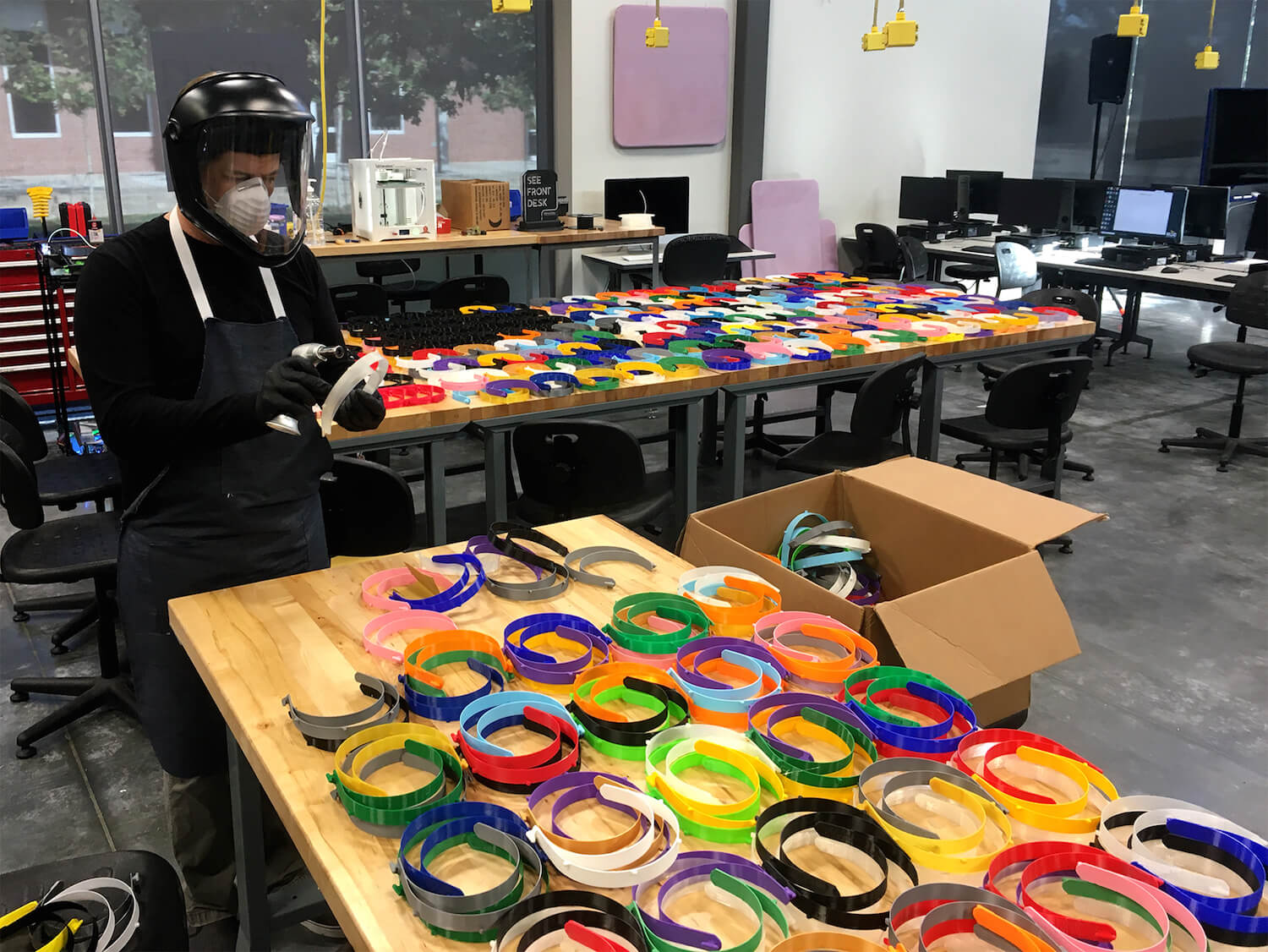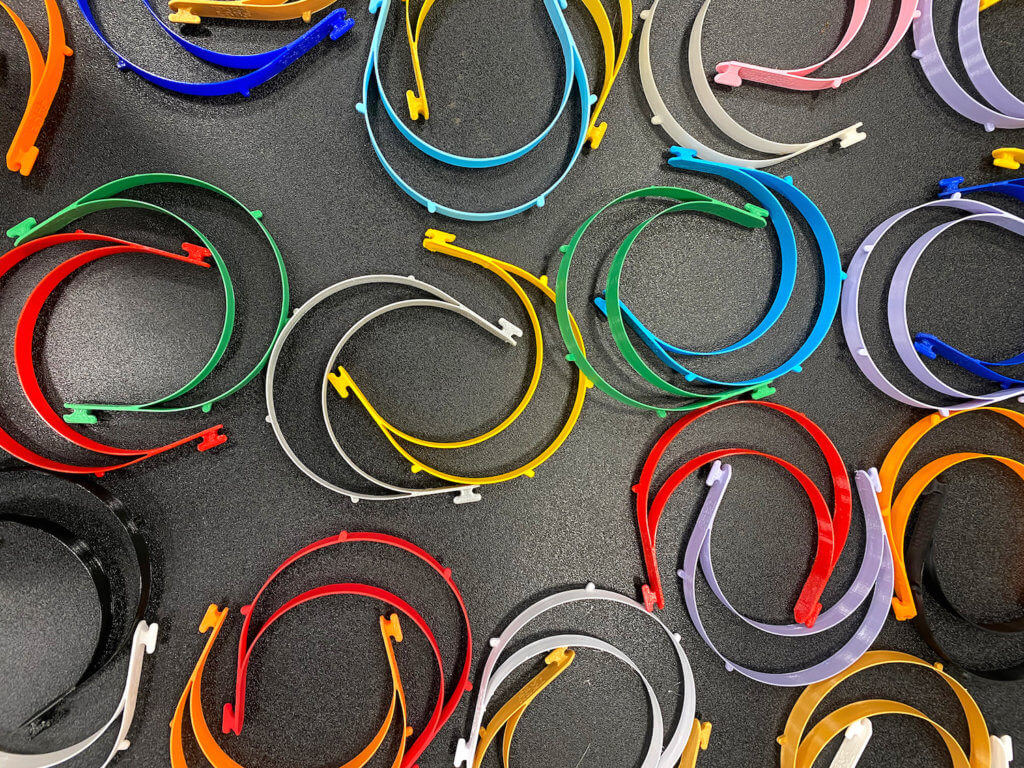Houston Community College and local nonprofit TX/RX Labs to manufacture face shields

As the world grapples with a shortage of personal protective equipment (PPE) for health care workers battling the COVID-19 pandemic, Houston Community College has mobilized its legion of 3D printers to meet the need in Houston.
The project began when local nonprofit TX/RX Labs, a makerspace focused on innovation and education, began producing face shields for the Memorial Hermann Health System when PPE supplies began running low. When HCC officials learned of these efforts, they knew they could offer help through the college’s IDEAStudio at the West Houston Institute and the Advanced Manufacturing Center of Excellence at HCC’s Stafford Campus.
“Just between those two locations we have more than 60 3D printers,” said Kurt Ewen, Ph.D., HCC’s vice chancellor of strategy, planning & institutional effectiveness. “The really exciting part is that this has already expanded, so San Jacinto College, HISD and Alief ISD are now working with us in this project. We’re going to be close to double the capacity that HCC brought to the conversation.”
::::::::::::::::::::::::::::::::::::::::::::::::::::::::::::::::::::::::::::::::::::::::::::::::::::::::::::::::::::::::::::::::::::::::::::::::::::::
Looking for the latest on the CORONAVIRUS? Read our daily updates HERE.
::::::::::::::::::::::::::::::::::::::::::::::::::::::::::::::::::::::::::::::::::::::::::::::::::::::::::::::::::::::::::::::::::::::::::::::::::::::
Originally, the collaboration hoped to create as many as 30,000 face shields a day. That was a miscalculation, Ewen said, but production still will be significant.
“We are going to be able to supply a tremendous amount of the face shields that are needed,” he said, adding that production requires minimal manpower—a plus when Harris County and the City of Houston are encouraging individuals to stay home. Even more, TX/RX Labs has shared its design specifications for the face shields, enabling individuals or organizations with access to a 3D printer to join the effort.
“We’re inviting the community to consider engaging in this work with us and saying, ‘If you have a machine at home and you can print five a week, awesome,’” Ewen said.
“Essential critical infrastructure”
On March 26, Harris County Judge Lina Hidalgo approved a waiver that allowed HCC to operate as “essential critical infrastructure”—part of the Stay Home, Work Safe order—for the purpose of producing mass quantities of protective face shields to support area medical facilities including Memorial Hermann-Texas Medical Center, The University of Texas MD Anderson Cancer Center and Baylor College of Medicine.
In a statement, Judge Hidalgo said that medical workers were on the front lines of the COVID-19 pandemic and needed protection.
“These are extraordinary times that require all of us to think creatively and offer up our resources, and I commend HCC for seeing this as an opportunity to help our hospital system fill a critical need,” she said.
HCC’s 3D printers are capable of producing only part of the face shield—what Ewen described as the “brackets,” or the headbands that hold the protective plastic in place. Globally, there is a growing shortage of the protective plastic, he said, which will likely be the biggest hurdle as they ramp up production.
“The brackets require filament to run through the 3D printers, but the big challenge right now is access to the plastic shield at the front,” Ewen said, adding that he is working with business leaders in Houston to try to develop new partners and material pipelines to keep production at capacity.
“The shield needs to be able to offer protection but then also offer [visual] clarity, so the preferred material is PETG, which is the kind of material our water bottles are made from,” explained Jordan Carswell, HCC program director for IDEAStudio & IDEAS Academy at the West Houston Institute. “A lot of the suppliers that we have talked to are two to three weeks out, and it went from them saying, ‘Yes, we’re having a shipment Monday,’ to, ‘Yes, we’re still having a shipment Monday, but you can’t have it—and neither can you have the next two to three shipments.’ … That is the material that seems to be the hardest to find right now.”

3D-printed brackets for protective face shields. (Courtesy photo)
“Out-of-the-box thinking”
Currently, the production process begins with HCC printing the brackets on their 3D printers, then delivering them in bulk to TX/RX Labs. HCC has already printed and delivered more than 1,000 brackets to TX/RX Labs for assembly, with another 800 on the way. Once there, a team connects the protective plastic to the headbands; when assembly is complete, the face shields are sent out to be cleaned, sanitized and packaged for distribution to the medical facility in need.
“If we had the plastic ready to go on site, we could do the cutting at our sites at HCC and all of the production could be done at the same location, minimizing the transportation time,” Ewen said. “But this is the story all across the United States: Everybody is looking for the same product.”
Although the shortage presents a challenge, Carswell noted, it’s also a positive sign.
“The good news is that I think that is because everybody is making face shields—private industry and public,” Carswell said. “But people are figuring out ways around that by finding other materials that can be used. I talked to a supplier of 3D filament that said they were using rolls of X-ray film. … People are being really creative and I think that’s been very interesting, to see all the on-the-spot and out-of-the-box thinking to figure it out.”
HCC is up for the challenge—and they’re not stopping at face shields.
“We are working with our fashion design teams at our Central Campus and the local sewing community and inviting people at home to sew face masks,” Ewen said, noting new recommendations from the Centers for Disease Control and Prevention that individuals wear cloth face coverings to help stop the spread of COVID-19. “There are better and worse ways to do this with regular fabric, so we are sharing information with specific specifications to follow.”
HCC will also share drop-off locations for community members who wish to sew masks and donate them to groups in need, he said, including police officers, first responders and community members who may not otherwise have access to masks.
“We’re trying to make this a collaborative team effort around responding to the crisis,” Ewen said. “The role of a community college is to bring the community together and part of what we consider our mission is to be responsive to the needs of the community—traditionally through education—but we have resources that we can deploy in a situation like this to help people in other ways.”
Ultimately, he said, the opportunity to come together through innovation and for the good of the community is all part of education. Perhaps, this will be the most important lesson these students ever learn.




